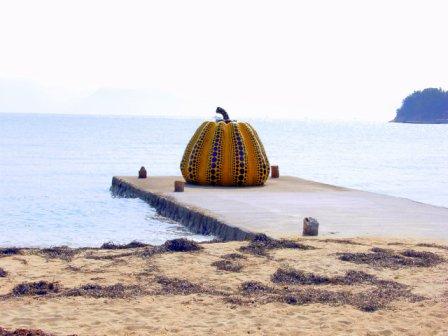It was a bit disconcerting, being led to a bench in a pitch-black room and being told to sit there, wait, and let my eyes adjust until I could see. So I sat there for five minutes, maybe ten, worrying I’d be the first person in the history of this room who failed to see anything at all, when I finally made out a faint glow that gradually, ever so slowly, grew into an entire wall of light at the far end of the room. I was amazed I hadn’t seen it before, and when I was told I could get up and touch it, I groped my way across the room, arms outstretched, until I bumped into a rail barrier that prevented me from going any further, leaving me grasping nothing but thin air.
Now this was an art installation with attitude! And it was only the beginning of a day on Naoshima, an island in the Seto Inland Sea that’s devoted to cutting-edge contemporary art and architecture that lifts visitors out of the ordinary and propels them on a journey of discovery. As a precursor perhaps of contemporary art to come, Naoshima eschews the confines of the usual museum experiencs: spectators looking passively at paintings on a wall, in favor of installations that provoke thought and demand participation. Known as the Benesse Art Site Naoshima, it offers two striking museums, interactive installations housed in traditional buildings, and outdoor sculptures spread throughout the island in a combination of beauty both natural and manmade. My experience described above took place in Minamidera, one of four commissioned, permanent Art House Projects, which team artists with traditional architecture. Designed by renowned architect Tadao Ando, Minamidera is a starkly simple building of blackened cedar (a traditional method for preventing fire and infestation) constructed to house James Turrell’s Backside of the Moon. Kadoya, a 200-year-old farmhouse, contains a darkened room with an installation by Tatsuo Miyajima, who designed a shallow pool with 125 submerged colored numbers that blink on and off at various frequencies, each one representing a human life and controlled by an islander who determines the number’s lifespan. Go’o Jinja is an Edo-era shrine that has been transformed by Hiroshi Sugimoto with the addition of glass stairs and a narrow underground passageway that leads to a traditional tomb-like room.
Read the full article on:
Japan’s Hippest Island | Only in Japan.
photo credit: Telstar Logistics via photopin cc







